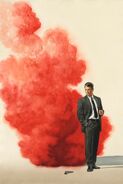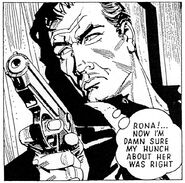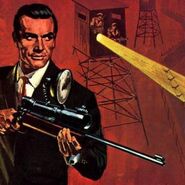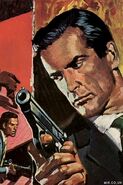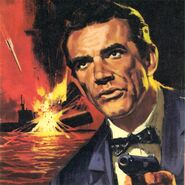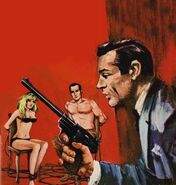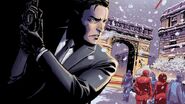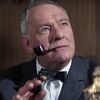
|
I want you to clean up this mess, 007 This article or section needs to be cleaned up to conform to a higher standard of article quality. Please follow the guidelines in the Manual of Style and complete this article to the highest level of quality before continuing on smaller articles. |
- "The name's Bond... James Bond."
- ― James Bond
Royal Navy Commander James Bond, CMG, RNVR, is a Secret Service agent, code number 007, residing in London but active internationally. Bond has an an enjoyment of cars, a love of food and drink, and an average intake of sixty custom-made cigarettes a day.
The Bond character was created by British journalist and novelist Ian Fleming in 1953. He is the main protagonist of the James Bond series of novels, films, comics and video games. Bond was a composite character who was based on a number of commandos who Fleming knew during his service in the Naval Intelligence Division during World War II, to whom Fleming added his own style and a number of his own tastes; Bond's name was appropriated from American ornithologist James Bond.[11] Fleming wrote twelve Bond novels and two short story collections before his death, although the last two books — The Man with the Golden Gun and Octopussy and The Living Daylights — were published posthumously.
Since Fleming's death in 1964, there have been other authorised writers of Bond material, including John Gardner, who wrote fourteen novels and two novelizations and Raymond Benson, who wrote six novels, three novelizations and three short stories. There have also been five authors who wrote one book each, Kingsley Amis (writing as Robert Markham), Sebastian Faulks, Jeffery Deaver, William Boyd and Anthony Horowitz. Additionally a series of novels based on Bond's youth—Young Bond—was written by Charlie Higson and Steve Cole.
History[]
Background[]
In the novels, Bond's parents (Andrew Bond of Scotland and Monique Delacroix Bond of the Canton de Vaud, Switzerland) were tragically killed during a climbing accident in the French Alps when he was eleven. He had acquired a first-class command of the French and German languages during his early education, which he received entirely abroad due to his father's work as a Vickers armaments company representative. After the death of his parents, Bond goes to live with his aunt, Miss Charmian Bond in the small village of Pett Bottom, Canterbury, where he completed his early education. Later, he briefly attends Eton College at "12 or thereabouts", but is removed after two terms because of girl trouble with a maid. After leaving Eton, Bond was sent to Fettes College in Scotland, his father's school.[12] On his first visit to Paris at the age of sixteen, Bond lost his virginity, later reminiscing about the event in "From a View to a Kill".[13]
After leaving Fettes, Bond studies briefly attending the University of Geneva (as did Fleming), before being taught to ski in Kitzbühel by Hannes Oberhauser.[14] Following his graduation, Bond joined the Ministry of Defence shortly before the outbreak of World War II. Bond applied to M for a position within the "Secret Service", part of the Civil Service, and rose to the rank of principal officer.
It was not until the penultimate novel, You Only Live Twice, that Fleming gave Bond a sense of family background, using a fictional obituary, purportedly from The Times. The book was the second to be written after the release of Dr. No in cinemas and Sean Connery's depiction of Bond affected Fleming's interpretation of the character, to give Bond both a sense of humour and Scottish antecedents that were not present in the previous stories.
At the start of Fleming's first book, Casino Royale, Bond is already a 00 agent having been given the position after killing two enemy agents, a Japanese spy on the thirty-sixth floor of the RCA Building at Rockefeller Centre in New York City and a Norwegian double agent who had betrayed two British agents; it is suggested by Bond scholar John Griswold that these were part of Bond's wartime service with Special Operations Executive (SOE), a British World War II covert military organisation. In 1954, according to the Soviet file on him in From Russia, With Love, Bond is made a Companion of the Order of St Michael and St George.
In Ian Fleming's stories, James Bond is in his mid-to-late thirties, but does not age. In Moonraker, he admits to being eight years shy of mandatory retirement age from the 00 section—forty-five—which would mean he was thirty-seven at the time. Fleming did not provide Bond's date of birth, but John Pearson's fictional biography of Bond, James Bond: The Authorised Biography of 007, gives him a birth date of 11 November 1920, whilst a study by Bond scholar John Griswold puts the date at 11 November 1921. According to Griswold, the Fleming novels take place between around May 1951, to February 1964, by which time Bond was aged 42.
Casino Royale[]
To be added
Live and Let Die[]
To be added
Moonraker[]
To be added
Diamonds are Forever[]
To be added
From Russia with Love[]
To be added
Dr. No[]
To be added
Goldfinger[]
To be added
For Your Eyes Only[]
To be added
Thunderball[]
To be added
The Spy Who Loved Me[]
To be added
On Her Majesty's Secret Service[]
To be added
You Only Live Twice[]
To be added
The Man with the Golden Gun[]
To be added
Octopussy and The Living Daylights[]
To be added
Colonel Sun[]
To be added
Licence Renewed[]
To be added
For Special Services[]
To be added
Icebreaker[]
To be added
Role of Honour[]
To be added
Nobody Lives for Ever[]
To be added
No Deals, Mr. Bond[]
To be added
Scorpius[]
To be added
Win, Lose or Die[]
To be added
Brokenclaw[]
To be added
The Man from Barbarossa[]
To be added
Death is Forever[]
To be added
Never Send Flowers[]
To be added
SeaFire[]
To be added
COLD[]
To be added
Zero Minus Ten[]
To be added
The Facts of Death[]
To be added
High Time to Kill[]
To be added
Doubleshot[]
To be added
Never Dream of Dying[]
To be added
The Man with the Red Tattoo[]
To be added
Devil May Care[]
To be added
Carte Blanche[]
To be added
Solo[]
To be added
Trigger Mortis[]
To be added
Forever and a Day[]
To be added
With a Mind to Kill[]
To be added
Double or Nothing[]
To be added
Personal life[]
Bond lives in a flat off the King's Road in Chelsea, in London. His flat is looked after by an elderly Scottish housekeeper named May. May's name was taken from May Maxwell, the housekeeper of Fleming's close friend, the American Ivar Bryce. In 1955 Bond earned around £2,000 a year net (£47,321 in 2017 pounds), although when on assignment he worked on an unlimited expense account. Much of Fleming's own daily routine whilst working at The Sunday Times was woven into the Bond stories and he summarised it at the beginning of Moonraker:
- "..elastic office hours from around ten to six; lunch, generally in the canteen; evenings spent playing cards in the company of a few close friends, or at Crockford's; or making love, with rather cold passion, to one of three similarly disposed married women; weekends playing golf for high stakes at one of the clubs near London."
- —Moonraker, Chapter 1: Secret paper-work
Only once in the series does Fleming install a partner for Bond in his flat, with the arrival of Tiffany Case, following Bond's mission to the US in Diamonds Are Forever. By the start of the following book, From Russia, With Love, Case had left to marry an American. Bond was married only once, in On Her Majesty's Secret Service, to Teresa "Tracy" di Vicenzo, but their marriage was short-lived as she was killed on their wedding day by Ernst Stavro Blofeld.
In the penultimate novel of the series, You Only Live Twice, Bond suffers from amnesia and has a relationship with an Ama diving girl, Kissy Suzuki. As a result of the relationship Kissy becomes pregnant, although she does not reveal this to Bond before he leaves the island.
In Never Send Flowers it is said that at some point in his life Bond visited Disney World with a girlfriend, intending to stay only two days, but liked the park so much that they had stayed for a whole week. Bond also showed that he recognized a great deal of Disney's characters.
Inspiration[]
Fleming took the name for his character from that of the American ornithologist James Bond, a Caribbean bird expert and author of the definitive field guide Birds of the West Indies; Fleming, a keen birdwatcher himself, had a copy of Bond's guide and he later explained to the ornithologist’s wife that "It struck me that this brief, unromantic, Anglo-Saxon and yet very masculine name was just what I needed, and so a second James Bond was born". He further explained that:
- "When I wrote the first one in 1953, I wanted Bond to be an extremely dull, uninteresting man to whom things happened; I wanted him to be a blunt instrument...when I was casting around for a name for my protagonist I thought by God, (James Bond) is the dullest name I ever heard."
- —Ian Fleming, The New Yorker, 21 April 1962
On another occasion Fleming said: "I wanted the simplest, dullest, plainest-sounding name I could find, "James Bond" was much better than something more interesting, like "Peregrine Carruthers". Exotic things would happen to and around him, but he would be a neutral figure—an anonymous, blunt instrument wielded by a government department."
Fleming based his creation on a number of individuals he came across during his time in the Naval Intelligence Division during World War II, admitting that Bond "was a compound of all the secret agents and commando types I met during the war". Amongst those types were his brother, Peter, whom Ian Fleming worshipped, and who had been involved in behind the lines operations in Norway and Greece during the war. Aside from Fleming's brother, a number of others also provided some aspects of Bond's make up, including Conrad O'Brien-French, a skiing spy whom Fleming had met in Kitzbühel in the 1930s, Patrick Dalzel-Job, who served with distinction in 30 AU during the war, and Bill "Biffy" Dunderdale, station head of MI6 in Paris, who wore cufflinks and handmade suits and was chauffeured around Paris in a Rolls-Royce. Sir Fitzroy MacLean was another figure mentioned as a possibility, based on his wartime work behind enemy lines in the Balkans, as was the MI6 double agent Dušan Popov.
Tastes[]
Beverages[]

Fleming biographer Andrew Lycett noted that, "within the first few pages [of Casino Royale] Ian had introduced most of Bond's idiosyncrasies and trademarks", which included his looks, his Bentley and his smoking and drinking habits. The full details of Bond's martini were kept until chapter seven of the book and Bond eventually named it "The Vesper", after Vesper Lynd.
Bond's drinking habits run throughout the series of books. During the course of On Her Majesty's Secret Service alone, Bond consumes forty-six drinks: Pouilly-Fuissé, Riquewihr and Marsala wines, most of a bottle of Algerian wine, some 1953 Château Mouton Rothschild claret, along with Taittinger and Krug champagnes and Babycham; for whiskies he consumes three bourbon and waters, half a pint of I.W. Harper bourbon, Jack Daniel's whiskey, two double bourbons on the rocks, two whisky and sodas, two neat scotches and one glass of neat whisky; vodka consumption totalled four vodka and tonics and three double vodka martinis; other sprits included two double brandies with ginger ale, a flask of Enzian Schnaps and a double gin: he also washed this down with four steins of German beer.

Blue Mountain Jamaican Coffee
For his non-alcoholic drinks, Bond eschews tea, calling it "mud" and blaming it for the downfall of the British Empire. He instead prefers to drink coffee. Perferably Blue Mountain Jamaican coffee.
Cuisine[]
When in England and not on a mission, Bond dines as simply as Fleming did on dishes such as grilled sole, oeufs en cocotte and cold roast beef with potato salad. When on a mission, however, Bond eats more extravagantly. This was partly because in 1953, when Casino Royale was published, many items of food were still rationed, and Bond was "the ideal antidote to Britain's postwar austerity, rationing and the looming premonition of lost power". This extravagance was more noteworthy with his contemporary readers for Bond eating exotic, local foods when abroad, at a time when most of his readership did not travel abroad.
On 1 April 1958 Fleming wrote to The Manchester Guardian in defence of his work, referring to that paper's review of Dr. No. Whilst referring to Bond's food and wine consumption as "gimmickery", Fleming bemoaned that "it has become an unfortunate trade-mark. I myself abhor Wine-and-Foodmanship. My own favourite food is scrambled eggs." Fleming was so keen on scrambled eggs that he used his short story, "007 in New York" to provide his favourite recipe for the dish: in the story, this came from the housekeeper of his friend Ivar Bryce, May, who gave her name to Bond's own housekeeper.
Bond believes that a steak has a flavour of its own, and as such should not be eaten with anything on it, save for salt and pepper.
Smoking[]

Bond is a heavy smoker, at one point smoking 70 cigarettes a day. Bond has his cigarettes custom-made by Morland of Grosvenor Street, mixing Balkan and Turkish tobacco and having a higher nicotine content than normal; the cigarettes have three gold bands on the filter. Bond carried his cigarettes in a wide gunmetal cigarette case which carried fifty; he also used a black oxidised Ronson lighter. The cigarettes were the same as Fleming's, who had been buying his at Morland since the 1930s; the three gold bands on the filter were added during the war to mirror his naval Commander's rank. On average, Bond smokes sixty cigarettes a day, although he cut back to around twenty five a day after his visit to a health farm in Thunderball. Fleming himself smoked up to 80 cigarettes a day. In Carte Blanche he is a former smoker.
Drugs[]
Bond occasionally supplements his alcohol consumption with the use of other drugs, for both functional and recreational reasons: Moonraker sees Bond consume a quantity of the amphetamine benzedrine accompanied by champagne, before his bridge game with Sir Hugo Drax (also consuming a carafe of vintage Riga vodka and a vodka martini); he also uses the drug for stimulation on missions, such as swimming across Shark Bay in Live and Let Die, or remaining awake and alert when threatened in the Dreamy Pines Motor Court in The Spy Who Loved Me. Despite this, in Devil May Care, set after the events of The Man wit the Golden Gun, Bond was offered raw Opium to smoke by Darius Alizadeh, but in order to keep his senses sharp for his mission he politely refused.
Looks[]
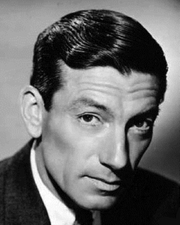
Hoagy Carmichael
Facially, Bond resembles the composer, singer and actor Hoagy Carmichael. In Casino Royale Vesper Lynd remarks, "Bond reminds me rather of Hoagy Carmichael, but there is something cold and ruthless." Likewise, in Moonraker, Special Branch Officer Gala Brand thinks that Bond is "certainly good-looking . . . Rather like Hoagy Carmichael in a way. That black hair falling down over the right eyebrow. Much the same bones. But there was something a bit cruel in the mouth, and the eyes were cold." Others, such as journalist Ben Macintyre, identify aspects of Fleming's own looks in his description of Bond. General references in the novels describe Bond as having "dark, rather cruel good looks".
In the novels (notably From Russia, with Love), Bond's physical description has generally been consistent: slim build; a three-inch long, thin vertical scar on his right cheek; blue-grey eyes; a "cruel" mouth; short, black hair, a comma of which falls on his forehead. Physically he is described as 183 centimetres (6 feet) in height and 76 kilograms (167 lb) in weight. After Casino Royale, Bond also had the faint scar of the Russian cyrillic letter "Ш" (SH) (for Shpion: "Spy") on the back of one of his hands, carved by a SMERSH agent.
Abilities[]

From Casino Royale to From Russia, with Love, Bond's preferred weapon is a .25 ACP Beretta automatic pistol carried in a light-weight chamois leather holster. However Fleming was contacted by a Bond enthusiast and gun expert, Geoffrey Boothroyd, who criticised Fleming's choice of firearm for Bond and suggested a Walther PPK 7.65mm instead. Fleming used the suggestion in Dr. No, also taking advice that it should be used with the Berns-Martin triple draw shoulder holster. By way of thanks, the MI6 Armourer who gives Bond his gun was given the name Major Boothroyd, and is introduced by M as "the greatest small-arms expert in the world".
Kingsley Amis, in The James Bond Dossier, noted that although Bond is a very good shot and the best in the Secret Service, he is still beaten by the instructor, something that added realism to Bond's character. Amis identified a number of skills where Bond is very good, but is still beatable by others. These included skiing, hand-to-hand combat, underwater swimming and golf. Driving was also an ability Amis identified where Bond was good, but others were better; one of those who is a better driver than Bond is Sir Hugo Drax, who causes Bond to write off his battleship-grey Bentley 4½ Litre with an Amherst Villiers supercharger. Bond subsequently drives a Mark II Continental Bentley, which he uses in the remaining books of the series, although he is issued an Aston Martin DB Mark III with a homing device during the course of Goldfinger.
[]
Ian Fleming novels[]
Whilst serving in the Naval Intelligence Division, Fleming had planned to become an author and had told a friend, "I am going to write the spy story to end all spy stories." On 17 February 1952, he began writing his first James Bond novel, Casino Royale at his Goldeneye estate in Jamaica, where he wrote all his Bond novels, during the months of January and February each year. He started the story shortly before his wedding to his pregnant girlfriend, Ann Charteris, in order to distract himself from his forthcoming nuptials.
After completing the manuscript for Casino Royale, Fleming showed the manuscript to his friend (and later editor) William Plomer to read. Plomer liked it and submitted it to the publishers, Jonathan Cape, who did not like it as much. Cape finally published it in 1953 on the recommendation of Fleming's older brother Peter, an established travel writer. Between 1953 and 1966, two years after his death, twelve novels and two short-story collections were published, with the last two books – The Man with the Golden Gun and Octopussy and The Living Daylights – published posthumously. All the books were published in the UK through Jonathan Cape.
|
|
Post-Fleming novels[]
After Fleming's death a continuation novel, Colonel Sun, was written by Kingsley Amis (as Robert Markham) and published in 1968. Amis had already written a literary study of Fleming's Bond novels in his 1965 work, The James Bond Dossier. Although novelizations of two of the Eon Productions Bond films appeared in print, James Bond, The Spy Who Loved Me and James Bond and Moonraker, both written by screenwriter Christopher Wood, the series of novels did not continue until the 1980s. In 1981, thriller writer John Gardner picked up the series with Licence Renewed. Gardner went on to write sixteen Bond books in total; two of the books he wrote – Licence to Kill and GoldenEye – were novelizations of Eon Productions films of the same name. Gardner moved the Bond series into the 1980s, although he retained the ages of the characters as they were when Fleming had left them. In 1996, Gardner retired from writing James Bond books due to ill health.
|
|
In 1996, American author Raymond Benson became the author of the Bond novels. Benson had previously been the author of The James Bond Bedside Companion, first published in 1984. By the time he moved on to other, non-Bond related projects in 2002, Benson had written six Bond novels, three novelizations and three short stories.
|
|
After a gap of six years, Sebastian Faulks was commissioned by Ian Fleming Publications to write a new Bond novel, which was released on 28 May 2008, the 100th anniversary of Ian Fleming's birth. The book — titled Devil May Care — was published in the UK by Penguin Books and by Doubleday in the US. American writer Jeffery Deaver was then commissioned by Ian Fleming Publications to produce Carte Blanche, which was published on 26 May 2011. The book updated Bond into a post 9/11 agency, independent of MI5 or MI6. In September 2013 William Boyd's Solo was released, taking Bond on a self-appointed mission. Then, in 2015, Anthony Horowitz published Trigger Mortis, a novel set immediately after the events of Goldfinger and built upon an unfinished short story by Fleming himself. After a positive reaction to the novel, Horowitz wrote a second Bond novel (also with material from Fleming) named Forever and a Day, released on May 31st 2018.[15] After the positive reaction of the novel, he wrote a third novel,(also with material from Fleming) named With a Mind to Kill, which was published on May 26th 2022.
|
Young Bond[]
- Main article: Young Bond
The Young Bond series of novels was started by Charlie Higson and, between 2005 and 2009, five novels and one short story were published. The first Young Bond novel, SilverFin was also adapted and released as a graphic novel on 2 October 2008 by Puffin Books. Beginning in 2014, the series was revived by Random House under new author Steve Cole, who wrote an additional four novels up to 2017.
|
Gallery[]
Novel illustrations[]
Comic illustrations[]
See also[]
- James Bond (Sean Connery)
- James Bond (George Lazenby)
- James Bond (Roger Moore)
- James Bond (Timothy Dalton)
- James Bond (Pierce Brosnan)
- James Bond (Daniel Craig)
- James Bond (Toby Stephens)
References[]
- ↑ Fleming, Ian (2006). "Chapter 3: The Impossible Mission", You Only Live Twice (in English). Penguin Classics.
- ↑ Fleming, Ian (2006). "Chapter 14: He Disagreed With Something That Ate Him", Live and Let Die (in English). Penguin Classics.
- ↑ Fleming, Ian (2006). "Chapter 3: Hot Ice", Diamonds Are Forever (in English). Penguin Classics.
- ↑ Fleming, Ian (2006). "Chapter 15: Background to a Spy", From Russia, with Love (in English). Penguin Classics.
- ↑ (1960) For Your Eyes Only. London, England: The Book Club. ISBN 978-1567310498.
- ↑ "Chapter 11: Bedtime Story", The Spy Who Loved Me
- ↑ Fleming, Ian (2006). "Chapter 8: Fancy Cover", On Her Majesty's Secret Service (in English). Penguin Classics.
- ↑ Fleming, Ian (2006). You Only Live Twice (in English). Penguin Classics.
- ↑ Fleming, Ian (2006). "007 in New York", Octopussy and The Living Daylights (in English). Penguin Classics. p.113
- ↑ 10.0 10.1 Fleming, Ian (2012). The Man with the Golden Gun. Random House.
- ↑ Salvador, R.B. & Tomotani, B.M. 2015. The birds of James Bond. Journal of Geek Studies 2(1): 1-9. Available from: https://jgeekstudies.org/2015/05/10/the-birds-of-james-bond/
- ↑ (2004) You Only Live Twice. Kent, England: Penguin Books, pp.200-202. ISBN 978-0-1411-8754-9.
- ↑ (1960) For Your Eyes Only. London, England: The Book Club, p.11. ISBN 978-1567310498.
- ↑ (2006) Octopussy and The Living Daylights. Kent, England: Penguin Books, p.35. ISBN 978-0-1411-8874-4.
- ↑ "Anthony Horowitz to Write the New James Bond Novel", Ian Fleming Publications, 4 October 2016. Retrieved on 5 January 2017.



